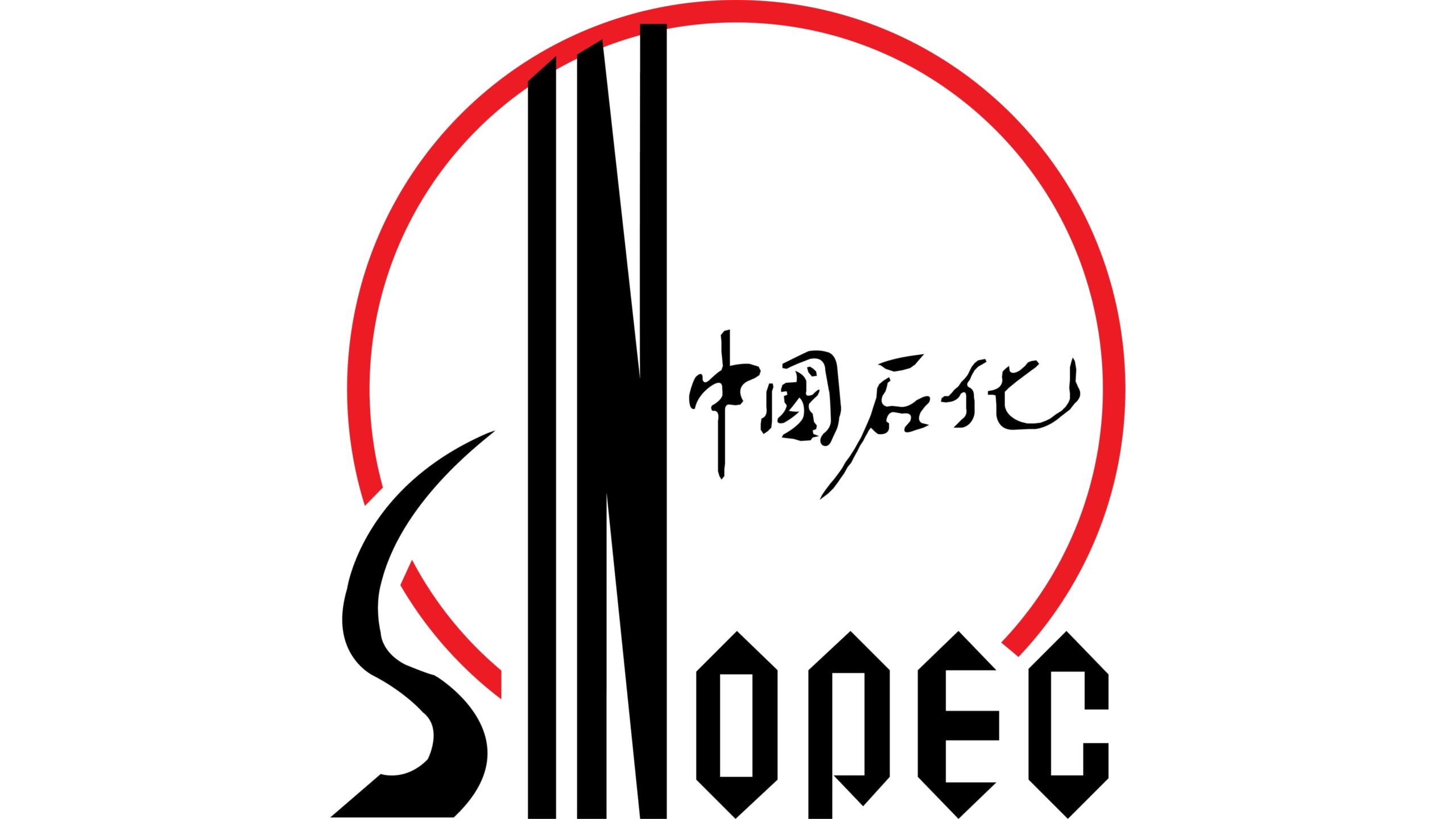Global Plastic Compounding Market: By Source, By Product, By End User, By Region & Segmental Insights Trends and Forecast, 2024 – 2034
- Industry: Chemicals & Materials
- Report ID: TNR-110-1119
- Number of Pages: 420
- Table/Charts : Yes
- June, 2024
- Base Year : 2024
- No. of Companies : 10+
- No. of Countries : 29
- Views : 10158
- Covid Impact Covered: Yes
- War Impact Covered: Yes
- Formats : PDF, Excel, PPT
Plastic compounding is the process of blending polymers with additives to create customized plastic materials with specific properties and performance characteristics. This process plays a critical role in enhancing the functionality, durability, and aesthetic qualities of plastic products across various industries, including automotive, electronics, packaging, and construction.
The base materials for plastic compounding are polymers and resins, which are derived from petrochemical feedstocks or bio-based sources. Common polymers used in compounding include polyethylene (PE), polypropylene (PP), polystyrene (PS), polyvinyl chloride (PVC), and polyethylene terephthalate (PET). Additives are essential components in plastic compounding, used to modify and enhance the properties of the base polymers.
These include stabilizers, plasticizers, flame retardants, impact modifiers, UV absorbers, colorants, and lubricants. Fillers such as calcium carbonate, talc, and glass fibres are used to improve mechanical strength, thermal stability, and other specific characteristics. The compounding process typically involves melting the base polymer and mixing it with additives and fillers using various techniques such as extrusion, kneading, and blending. Extrusion is the most common method, where the material is fed into an extruder, melted, mixed, and then shaped into pellets for further processing.
In terms of revenue, the global plastic compounding market was worth US$ 68.5 Bn in 2023, anticipated to witness CAGR of 7.2% During 2024 – 2034.
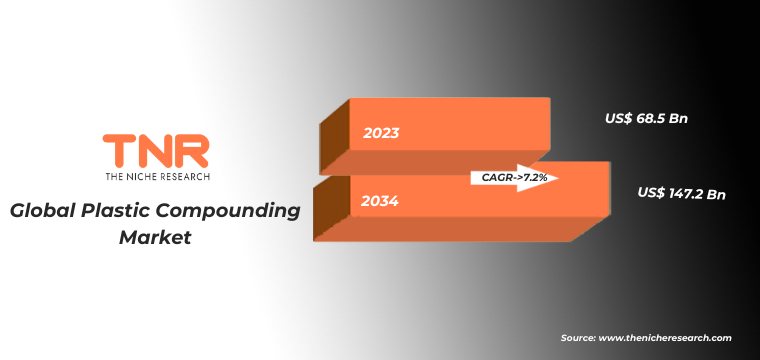
Global Plastic compounding Market Dynamics
Technological Advancements: Innovations in polymer science and compounding technologies are driving the market. Advanced compounding techniques enable the production of high-performance plastics with enhanced properties, such as improved strength, flexibility, thermal stability, and resistance to chemicals and UV radiation. These advancements support the development of new applications and expand the market potential.
Increasing Demand for High-Performance Materials: Industries such as automotive, aerospace, and electronics are increasingly demanding high-performance plastics to replace traditional materials like metals and ceramics. Plastics offer advantages such as lighter weight, corrosion resistance, and ease of processing. Compounded plastics with customized properties are essential in meeting the specific requirements of these industries.
Environmental Sustainability: The growing emphasis on sustainability and environmental protection is a significant driver for the plastic compounding market. There is increasing demand for eco-friendly materials, including bio-based and recycled plastics. Compounding processes are being developed to incorporate higher percentages of recycled content and to enhance the recyclability of plastics. This shift towards sustainable practices is supported by regulatory policies and consumer preferences.
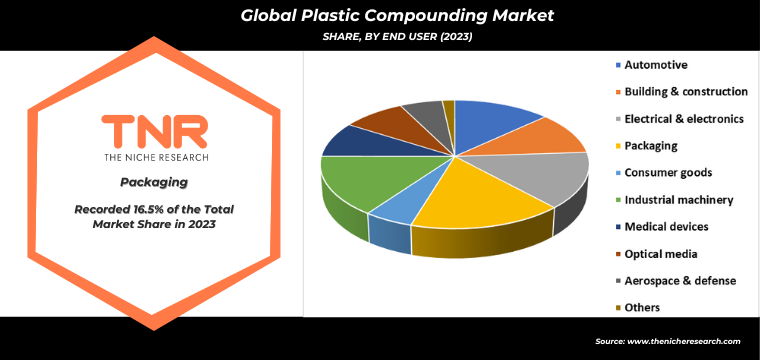
Fossil-based Plastic Compounding Has Garnered Major Market Share in the Global Plastic Compounding Market During the Forecast Period (2024 – 2034).
Technological innovations play a significant role in driving the demand for fossil-based plastic compounding. Continuous improvements in polymer science have led to the development of new polymer grades with enhanced properties. Advanced compounding technologies, such as twin-screw extrusion and reactive extrusion, allow for precise control over the incorporation of additives and fillers, resulting in high-performance materials tailored to specific applications.
These advancements not only improve the quality and performance of fossil-based plastics but also expand their applicability across various industries, from automotive to consumer goods. Fossil-based plastics offer a range of superior material properties that drive their demand in numerous applications. These properties include high tensile strength, chemical resistance, thermal stability, and flexibility. For instance, polyethylene (PE) and polypropylene (PP) are known for their durability and resistance to moisture and chemicals, making them ideal for packaging applications. Polyvinyl chloride (PVC) is valued for its versatility and is used in construction for pipes, fittings, and profiles. The ability to tailor these properties through compounding processes ensures that fossil-based plastics meet the specific needs of different industries, enhancing their demand.
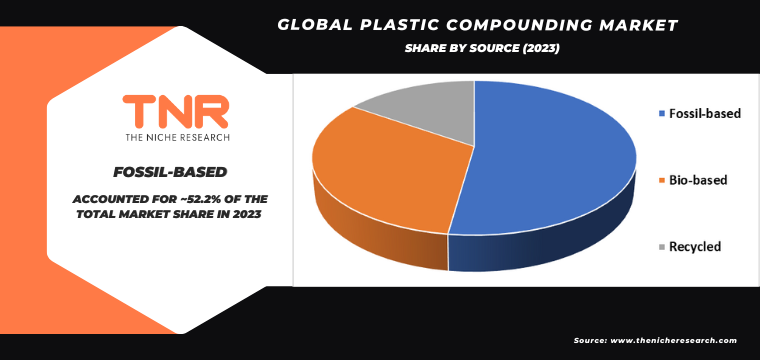
By Product Polypropylene Segment had the Highest Share in the Global Plastic Compounding Market in 2023.
Polypropylene (PP) is one of the most widely used polymers in plastic compounding due to its versatile properties, cost-effectiveness, and broad range of applications. Polypropylene’s superior material properties make it a preferred choice for plastic compounding. It offers a unique combination of high tensile strength, impact resistance, chemical resistance, and thermal stability. PP is also lightweight, which is a crucial factor in industries such as automotive and packaging. Its low density reduces the weight of final products, contributing to fuel efficiency in vehicles and reduced shipping costs in packaging.
Additionally, PP has good fatigue resistance and electrical insulation properties, making it suitable for a wide range of applications. The diverse applications of polypropylene across multiple industries are a major demand driver. In the automotive industry, PP is used for manufacturing various components such as bumpers, dashboards, and interior trim. Its lightweight nature helps in reducing vehicle weight, improving fuel efficiency, and lowering emissions. In the packaging industry, PP is valued for its excellent barrier properties, which protect products from moisture and contamination. It is used in food containers, bottles, and flexible packaging films.
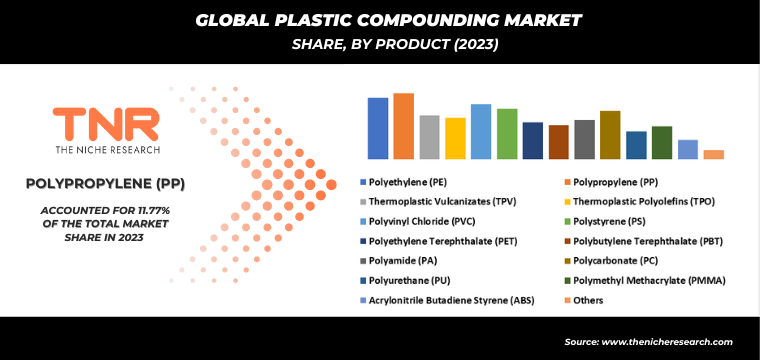
By Region Asia Pacific had the Highest Share in the Global Plastic Compounding Market in 2023.
Asia-Pacific is characterized by rapid industrialization and urbanization, particularly in emerging economies like China, India, and Southeast Asian countries. This industrial boom has led to increased demand for compounded plastics in construction, consumer goods, and infrastructure projects. The construction industry, for example, uses compounded plastics for pipes, fittings, insulation, and profiles due to their durability, corrosion resistance, and ease of installation. As urbanization continues, the need for efficient and sustainable building materials drives the compounding market.
Asia-Pacific is a global hub for electronics manufacturing, with countries like China, South Korea, Taiwan, and Japan leading in the production of consumer electronics, semiconductors, and other electronic components. Compounded plastics are essential in this industry due to their electrical insulation properties, thermal stability, and flame retardancy. They are used in housings, connectors, cables, and various electronic components. The continuous growth of the electronics industry, driven by innovations and increasing consumer demand, significantly boosts the plastic compounding market.
The automotive industry in Asia-Pacific is expanding at a fast pace, with countries like China, Japan, South Korea, and India being major automotive manufacturers. Compounded plastics are crucial in automotive applications for reducing vehicle weight, enhancing fuel efficiency, and improving overall performance. Polypropylene (PP), polyethylene (PE), and polyvinyl chloride (PVC) are widely used in automotive components such as bumpers, dashboards, interior trims, and under-the-hood parts. The region’s focus on producing lightweight and energy-efficient vehicles is a significant driver for the plastic compounding market.
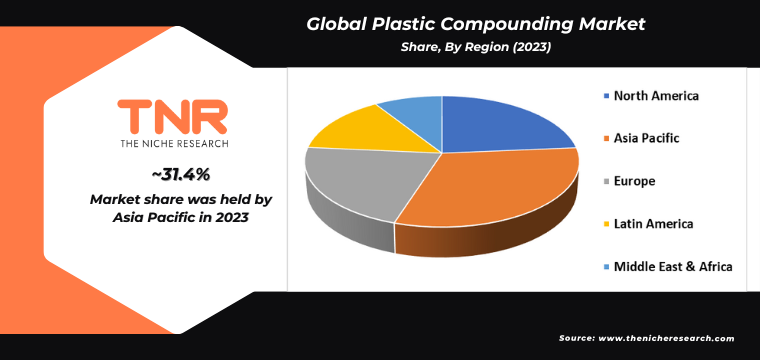
Competitive Landscape: Global Plastic Compounding Market:
- Asahi Kasei Corporation
- BASF SE
- Covestro AG
- Dow, Inc.
- DuPont de Nemours, Inc.
- Eurostar Engineering Plastics
- KRATON CORPORATION
- LyondellBasell Industries Holdings B.V.
- RTP Company
- S&E Specialty Polymers, LLC
- SABIC
- Washington Penn
- Other Industry Participants
Global Plastic Compounding Market Scope
| Report Specifications | Details |
| Market Revenue in 2023 | US$ 68.5 Bn |
| Market Size Forecast by 2034 | US$ 147.2 Bn |
| Growth Rate (CAGR) | 7.2% |
| Historic Data | 2016 – 2022 |
| Base Year for Estimation | 2023 |
| Forecast Period | 2024 – 2034 |
| Report Inclusions | Market Size & Estimates, Market Dynamics, Competitive Scenario, Trends, Growth Factors, Market Determinants, Key Investment Segmentation, Product/Service/Solutions Benchmarking |
| Segments Covered | By Source, By Product, By End User, By Region |
| Regions Covered | North America, Europe, Asia Pacific, Middle East & Africa, Latin America |
| Countries Covered | U.S., Canada, Mexico, Rest of North America, France, The UK, Spain, Germany, Italy, Nordic Countries (Denmark, Finland, Iceland, Sweden, Norway), Benelux Union (Belgium, The Netherlands, Luxembourg), Rest of Europe, China, Japan, India, New Zealand, Australia, South Korea, Southeast Asia (Indonesia, Thailand, Malaysia, Singapore, Rest of Southeast Asia), Rest of Asia Pacific, Saudi Arabia, UAE, Egypt, Kuwait, South Africa, Rest of Middle East & Africa, Brazil, Argentina, Rest of Latin America |
| Key Players | Asahi Kasei Corporation, BASF SE, Covestro AG, Dow, Inc., DuPont de Nemours, Inc., Eurostar Engineering Plastics, KRATON CORPORATION, LyondellBasell Industries Holdings B.V., RTP Company, S&E Specialty Polymers, LLC, SABIC, Washington Penn |
| Customization Scope | Customization allows for the inclusion/modification of content pertaining to geographical regions, countries, and specific market segments. |
| Pricing & Procurement Options | Explore purchase options tailored to your specific research requirements |
| Contact Details | Consult With Our Expert
Japan (Toll-Free): +81 663-386-8111 South Korea (Toll-Free): +82-808- 703-126 Saudi Arabia (Toll-Free): +966 800-850-1643 United Kingdom: +44 753-710-5080 United States: +1 302-232-5106 E-mail: askanexpert@thenicheresearch.com
|
Global Plastic Compounding Market
By Source
- Fossil-based
- Bio-based
- Recycled
By Product
- Polyethylene (PE)
- Polypropylene (PP)
- Thermoplastic Vulcanizates (TPV)
- Thermoplastic Polyolefins (TPO)
- Polyvinyl Chloride (PVC)
- Polystyrene (PS)
- Polyethylene Terephthalate (PET)
- Polybutylene Terephthalate (PBT)
- Polyamide (PA)
- Polycarbonate (PC)
- Polyurethane (PU)
- Polymethyl Methacrylate (PMMA)
- Acrylonitrile Butadiene Styrene (ABS)
- Others
By End User
- Automotive
- Building & construction
- Electrical & electronics
- Packaging
- Consumer goods
- Industrial machinery
- Medical devices
- Optical media
- Aerospace & defense
- Others
By Region
- North America (U.S., Canada, Mexico, Rest of North America)
- Europe (France, The UK, Spain, Germany, Italy, Nordic Countries (Denmark, Finland, Iceland, Sweden, Norway), Benelux Union (Belgium, The Netherlands, Luxembourg), Rest of Europe)
- Asia Pacific (China, Japan, India, New Zealand, Australia, South Korea, Southeast Asia (Indonesia, Thailand, Malaysia, Singapore, Rest of Southeast Asia), Rest of Asia Pacific)
- Middle East & Africa (Saudi Arabia, UAE, Egypt, Kuwait, South Africa, Rest of Middle East & Africa)
- Latin America (Brazil, Argentina, Rest of Latin America)
Report Layout
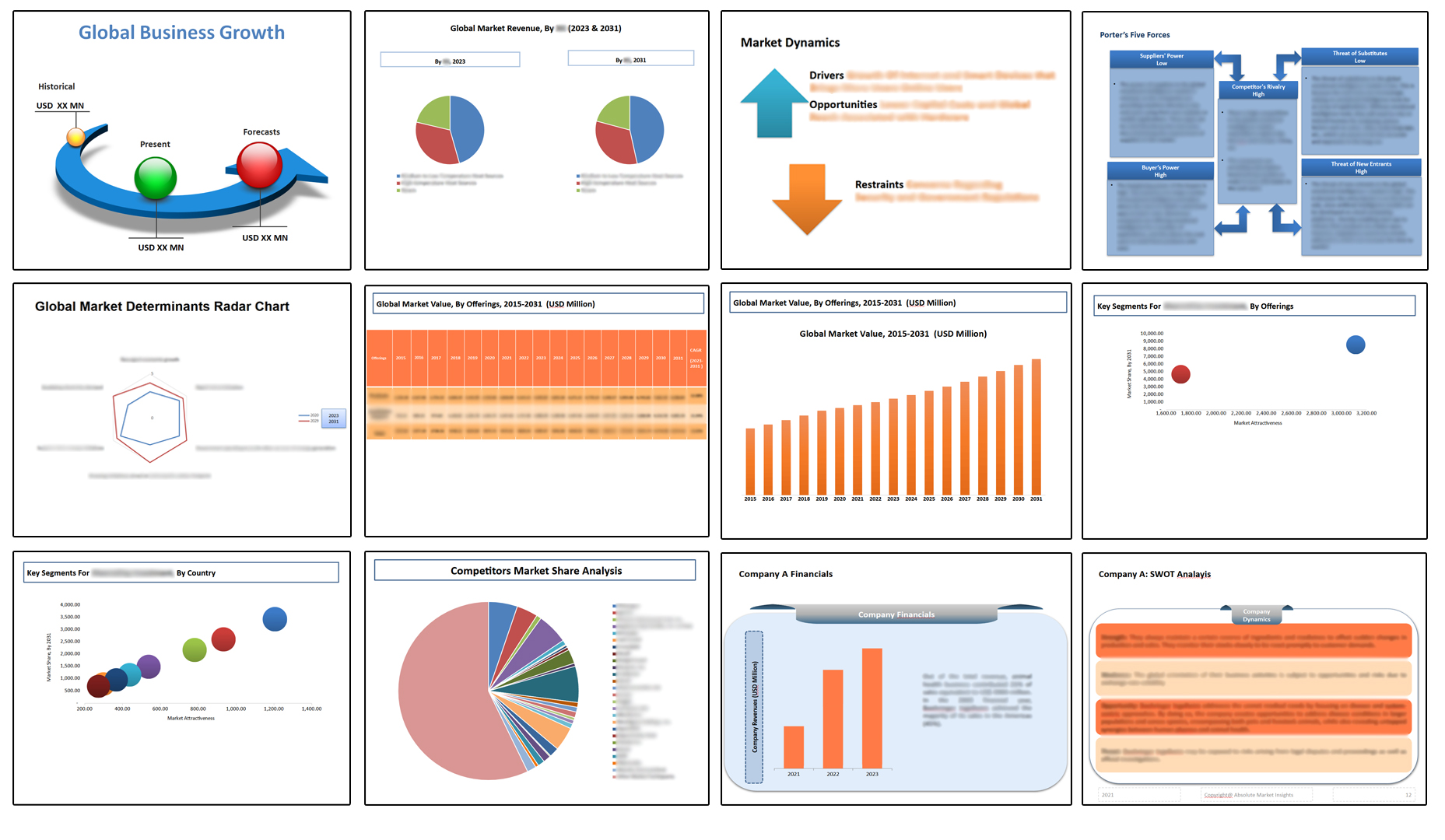
Table of Contents
Note: This ToC is tentative and can be changed according to the research study conducted during the course of report completion.
**Exclusive for Multi-User and Enterprise User.
Global Plastic Compounding Market
By Source
- Fossil-based
- Bio-based
- Recycled
By Product
- Polyethylene (PE)
- Polypropylene (PP)
- Thermoplastic Vulcanizates (TPV)
- Thermoplastic Polyolefins (TPO)
- Polyvinyl Chloride (PVC)
- Polystyrene (PS)
- Polyethylene Terephthalate (PET)
- Polybutylene Terephthalate (PBT)
- Polyamide (PA)
- Polycarbonate (PC)
- Polyurethane (PU)
- Polymethyl Methacrylate (PMMA)
- Acrylonitrile Butadiene Styrene (ABS)
- Others
By End User
- Automotive
- Building & construction
- Electrical & electronics
- Packaging
- Consumer goods
- Industrial machinery
- Medical devices
- Optical media
- Aerospace & defense
- Others
By Region
- North America (U.S., Canada, Mexico, Rest of North America)
- Europe (France, The UK, Spain, Germany, Italy, Nordic Countries (Denmark, Finland, Iceland, Sweden, Norway), Benelux Union (Belgium, The Netherlands, Luxembourg), Rest of Europe)
- Asia Pacific (China, Japan, India, New Zealand, Australia, South Korea, Southeast Asia (Indonesia, Thailand, Malaysia, Singapore, Rest of Southeast Asia), Rest of Asia Pacific)
- Middle East & Africa (Saudi Arabia, UAE, Egypt, Kuwait, South Africa, Rest of Middle East & Africa)
- Latin America (Brazil, Argentina, Rest of Latin America)
The Niche Research approach encompasses both primary and secondary research methods to provide comprehensive insights. While primary research is the cornerstone of our studies, we also incorporate secondary research sources such as company annual reports, premium industry databases, press releases, industry journals, and white papers.
Within our primary research, we actively engage with various industry stakeholders, conducting paid interviews and surveys. Our meticulous analysis extends to every market participant in major countries, allowing us to thoroughly examine their portfolios, calculate market shares, and segment revenues.
Our data collection primarily focuses on individual countries within our research scope, enabling us to estimate regional market sizes. Typically, we employ a bottom-up approach, meticulously tracking trends in different countries. We analyze growth drivers, constraints, technological innovations, and opportunities for each country, ultimately arriving at regional figures.Our process begins by examining the growth prospects of each country. Building upon these insights, we project growth and trends for the entire region. Finally, we utilize our proprietary model to refine estimations and forecasts.
Our data validation standards are integral to ensuring the reliability and accuracy of our research findings. Here’s a breakdown of our data validation processes and the stakeholders we engage with during our primary research:
- Supply Side Analysis: We initiate a supply side analysis by directly contacting market participants, through telephonic interviews and questionnaires containing both open-ended and close-ended questions. We gather information on their portfolios, segment revenues, developments, and growth strategies.
- Demand Side Analysis: To gain insights into adoption trends and consumer preferences, we reach out to target customers and users (non-vendors). This information forms a vital part of the qualitative analysis section of our reports, covering market dynamics, adoption trends, consumer behavior, spending patterns, and other related aspects.
- Consultant Insights: We tap into the expertise of our partner consultants from around the world to obtain their unique viewpoints and perspectives. Their insights contribute to a well-rounded understanding of the markets under investigation.
- In-House Validation: To ensure data accuracy and reliability, we conduct cross-validation of data points and information through our in-house team of consultants and utilize advanced data modeling tools for thorough verification.
The forecasts we provide are based on a comprehensive assessment of various factors, including:
- Market Trends and Past Performance (Last Five Years): We accurately analyze market trends and performance data from preceding five years to identify historical patterns and understand the market’s evolution.
- Historical Performance and Growth of Market Participants: We assess the historical performance and growth trajectories of key market participants. This analysis provides insights into the competitive landscape and individual company strategies.
- Market Determinants Impact Analysis (Next Eight Years): We conduct a rigorous analysis of the factors that are projected to influence the market over the next eight years. This includes assessing both internal and external determinants that can shape market dynamics.
- Drivers and Challenges for the Forecast Period:Identify the factors expected to drive market growth during the forecast period, as well as the challenges that the industry may face. This analysis aids in deriving an accurate growth rate projection.
- New Acquisitions, Collaborations, or Partnerships: We keep a close watch on any new acquisitions, collaborations, or partnerships within the industry. These developments can have a significant impact on market dynamics and competitiveness.
- Macro and Micro Factors Analysis:A thorough examination of both macro-level factors (e.g., economic trends, regulatory changes) and micro-level factors (e.g., technological advancements, consumer preferences) that may influence the market during the forecast period.
- End-User Sentiment Analysis: To understand the market from the end-user perspective, we conduct sentiment analysis. This involves assessing the sentiment, preferences, and feedback of the end-users, which can provide valuable insights into market trends.
- Perspective of Primary Participants: Insights gathered directly from primary research participants play a crucial role in shaping our forecasts. Their perspectives and experiences provide valuable qualitative data.
- Year-on-Year Growth Trend: We utilize a year-on-year growth trend based on historical market growth and expected future trends. This helps in formulating our growth projections, aligning them with the market’s historical performance.
Research process adopted by TNR involves multiple stages, including data collection, validation, quality checks, and presentation. It’s crucial that the data and information we provide add value to your existing market understanding and expertise. We have also established partnerships with business consulting, research, and survey organizations across regions and globally to collaborate on regional analysis and data validation, ensuring the highest level of accuracy and reliability in our reports.


